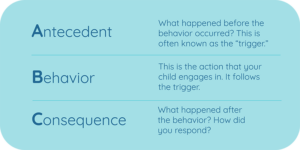Managing challenging behaviors in the moment can be difficult. You may not know how to respond. You may try many things to get your child to calm down. You may think it is happening for no reason. Below are some tips and tricks on why behaviors are occurring and how you can react.
First, let’s talk about why the behaviors are happening. There are 4 common reasons a challenging behavior may occur (after ruling out medical issues):
1. To escape or avoid a situation/demand.
2. To gain others’ attention.
3. To get what a child wants.
4. To feel good or do something pleasing. This type of behavior is automatically rewarding.
As your child is engaging in challenging behaviors, let’s think about the ABCs of behavior to help understand why this behavior is occurring.
Be proactive! Being proactive is all about what you can do to prevent the problem behavior from occurring. This can be anything from changing the order of events in your day and using visual schedules for your child to wording things differently, controlling the environment, and managing your expectations to meet your child where they are. Carving time out of your day to build a strong positive relationship is another great way to be proactive!
The behavior has happened. How do you respond?
1. Remain calm. It is going to be OK.
2. Ensure your child’s safety.
3. If the reason for your child’s behavior is to gain your attention, giving the behavior attention will only increase the likelihood of that behavior happening again. Ignore the behavior and use a neutral facial expression. (Teach your child to get attention appropriately when he/she is calm and, in a learning-ready state.)
4. Be sure not to allow access to what your child wants at the same time the behavior is occurring. This will only teach your child to engage in this behavior to get what he/she wants.
5. Avoid any bribing, reasoning, or arguing. Set the expectation before the behavior occurs rather than as it is occurring.
6. Praise your child towards any steps of calmness.
7. Choose a good time to prompt your child to communicate what it is he/she wants (through pointing, pictures, typing, verbalizing, etc.). Reward your child when he/she is engaging in appropriate communication. Remember to practice this appropriate communication multiple times a day, especially when your child is in a happy state. This is the best teaching time.
Children with autism often engage in particular behaviors to communicate what they want because they have no other way of communicating and have learned that engaging in a particular behavior is more effective. The next time your child engages in a challenging behavior, ask yourself, “What is my child trying to communicate?” and refer to the helpful tips above.






